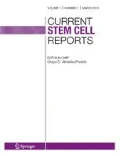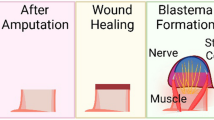Abstract
Purpose of Review
Recent advances in genomics and gene editing have expanded the range of model organisms to include those with interesting biological capabilities such as regeneration. Among these are the classic models of regeneration biology, the salamander. Although stimulating endogenous regeneration in humans likely is many years away, with advances in stem cell biology and biomedical engineering (e.g., bio-inspired materials), it is evident that there is great potential to enhance regenerative outcomes by approaching the problem from an engineering perspective. The question at this point is what do we need to engineer?
Recent Findings
The value of regeneration models is that they show us how regeneration works, which then can guide efforts to mimic these developmental processes therapeutically. Among these models, the accessory limb model (ALM) was developed in the axolotl as a gain-of-function assay for the sequential steps that are required for successful regeneration. To date, this model has identified a number of proregenerative signals, including growth factor signaling associated with nerves and signals associated with the extracellular matrix (ECM) that induce pattern formation.
Summary
Identification of these signals through the use of models in highly regenerative vertebrates (e.g., the axolotl) offers a wide range of possible modifications for engineering bioinspired, biomimetic materials to create a dynamic stem cell niche for regeneration and scar-free repair.

Similar content being viewed by others
References
Papers of particular interest, published recently, have been highlighted as: • Of importance •• Of major importance
Laurencin CT, Khan Y. Regenerative engineering. CRC Press; 2013.
Trounson A, DeWitt ND. Pluripotent stem cells progressing to the clinic. Nat Rev Mol Cell Biol. 2016;17:194–200.
Vishwakarma A, Karp JM. Biology and engineering of stem cell niches. Elsevier Science; 2017.
Bryant SV, Endo T, Gardiner DM. Vertebrate limb regeneration and the origin of limb stem cells. Int J Dev Biol. 2002;46:887–96.
• McCusker C, Gardiner DM, Bryant SV. The Axolotl limb blastema: cellular and molecular mechanisms driving blastema formation and limb regeneration in tetrapods. Regeneration (Oxf). 2015. This review provides the most current overview of the process of limb regeneration based largely on the axolotl regeneration model.
French V, Bryant PJ, Bryant SV. Pattern regulation in epimorphic fields. Science. 1976;193:969–81.
Bryant SV, French V, Bryant PJ. Distal regeneration and symmetry. Science. 1981;212:993–1002.
Putta S, Smith JJ, Walker JA, Rondet M, Weisrock DW, Monaghan J, et al. From biomedicine to natural history research: EST resources for ambystomatid salamanders. BMC Genomics. 2004;5:54.
Smith JJ, Putta S, Walker JA, Kump DK, Samuels AK, Monaghan JR, et al. Sal-Site: integrating new and existing ambystomatid salamander research and informational resources. BMC Genomics. 2005;6:181.
Voss SR, Epperlein HH, Tanaka EM. Ambystoma mexicanum, the axolotl: a versatile amphibian model for regeneration, development, and evolution studies. Cold Spring Harb Protoc. Cold Spring Harbor Laboratory Press; 2009; 2009:pdb.emo128–8.
Endo T, Bryant SV, Gardiner DM. A stepwise model system for limb regeneration. Dev Biol. 2004;270:135–45.
Bryant SV, Gardiner DM. The relationship between growth and pattern formation. Regeneration. 2016;3:103–22. doi:10.1002/reg2.55).
Voss SR, Palumbo A, Nagarajan R, Gardiner DM, Muneoka K, Stromberg AJ, et al. Gene expression during the first 28 days of axolotl limb regeneration I: experimental design and global analysis of gene expression. Regeneration (Oxf). 2015;2:120–36.
Zhu W, Pao GM, Satoh A, Cummings G, Monaghan JR, Harkins TT, et al. Activation of germline-specific genes is required for limb regeneration in the Mexican axolotl. Dev Biol. 2012;370:42–51.
Monaghan JR, Walker JA, Page RB, Putta S, Beachy CK, Voss SR. Early gene expression during natural spinal cord regeneration in the salamander Ambystoma mexicanum. J Neurochem. 2007;101:27–40.
Monaghan JR, Athippozhy A, Seifert AW, Putta S, Stromberg AJ, Maden M, et al. Gene expression patterns specific to the regenerating limb of the Mexican axolotl. Biol Open. The Company of Biologists Ltd. 2012;1:937–48.
Monaghan JR, Epp LG, Putta S, Page RB, Walker JA, Beachy CK, et al. Microarray and cDNA sequence analysis of transcription during nerve-dependent limb regeneration. BMC Biol. 2009;7:1.
Satoh A, Gardiner DM, Bryant SV, Endo T. Nerve-induced ectopic limb blastemas in the Axolotl are equivalent to amputation-induced blastemas. Dev Biol. 2007;312:231–44.
Maden M, Holder N. Axial characteristics of nerve induced supernumerary limbs in the axolotl. Roux's Arch Dev Biol. 1984;193:394–401.
Bodemer CW. The development of nerve-induced supernumerary limbs in the adult newt, Triturus viridescens. J Morphol. 1958;102:555–81.
Muller TL, Ngo-Muller V, Reginelli A, Taylor G, Anderson R, Muneoka K. Regeneration in higher vertebrates: limb buds and digit tips. Semin Cell Dev Biol. 1999;10:405–13.
Wallace H. Vertebrate Limb Regeneration. Chichester: John Wiley and Sons; 1981.
Tassava RA, Olsen CL. Higher vertebrates do not regenerate digits and legs because the wound epidermis is not functional. A hypothesis. Differentiation. 1982;22:151–5.
• Makanae A, Mitogawa K, Satoh A. Co-operative Bmp- and Fgf-signaling inputs convert skin wound healing to limb formation in urodele amphibians. Dev Biol. 2014;396:57–66. This paper demonstrates that a cocktail of human growth factors can substitute functionally for signaling from a nerve to induce blastema formation and maintain subsequent steps involved in limb regeneration.
Makanae A, Mitogawa K, Satoh A. Cooperative inputs of Bmp and Fgf signaling induce tail regeneration in urodele amphibians. Dev Biol. 2016;410:45–55.
Makanae A, Hirata A, Honjo Y, Mitogawa K, Satoh A. Nerve independent limb induction in axolotls. Dev Biol. 2013;381:213–26.
•• Phan AQ, Lee J, Oei M, Flath C, Hwe C, Mariano R, et al. Heparan sulfates mediate positional information by position-specific growth factor regulation during axolotl (Ambystoma mexicanum) limb regeneration. Regeneration (Oxf). 2015;2:182–201. This paper demonstrates that bioactive ECM from both axolotl and mouse limb skin can stimulate formation of ectopic limb structures in the axolotl Accessory Limb Model. Characterization of this activity leads to the conclusion that the signaling properties of the ECM are encoded by spatial- and temporal-specific modifications in the patterns of sulfation of glycosaminoglycans.
Gilbert SF. Developmental biology. 10th ed. Sunderland, MA: Sinauer Associates, Inc; 2013.
Yayon A, Klagsbrun M, Esko JD, Leder P, Ornitz DM. Cell surface, heparin-like molecules are required for binding of basic fibroblast growth factor to its high affinity receptor. Cell. 1991;64:841–8.
Sarrazin S, Lamanna WC, Esko JD. Heparan sulfate proteoglycans. Cold Spring Harb Perspect Biol. Cold Spring Harbor Lab. 2011;3:a004952.
Radice M, Brun P, Cortivo R, Scapinelli R, Battaliard C, Abatangelo G. Hyaluronan-based biopolymers as delivery vehicles for bone-marrow-derived mesenchymal progenitors. J Biomed Mater Res. 2000;50:101–9.
Baier Leach J, Bivens KA, Patrick CW, Schmidt CE. Photocrosslinked hyaluronic acid hydrogels: natural, biodegradable tissue engineering scaffolds. Biotechnol Bioeng. Wiley Subscription Services, Inc., A Wiley Company. 2003;82:578–89.
Kim J, Kim IS, Cho TH, Lee KB, Hwang SJ, Tae G, et al. Bone regeneration using hyaluronic acid-based hydrogel with bone morphogenic protein-2 and human mesenchymal stem cells. Biomaterials. 2007;28:1830–7.
Seidlits SK, Khaing ZZ, Petersen RR, Nickels JD, Vanscoy JE, Shear JB, et al. The effects of hyaluronic acid hydrogels with tunable mechanical properties on neural progenitor cell differentiation. Biomaterials. 2010;31:3930–40.
Ballios BG, Cooke MJ, van der Kooy D, Shoichet MS. A hydrogel-based stem cell delivery system to treat retinal degenerative diseases. Biomaterials. 2010;31:2555–64.
Ha C-W, Park Y-B, Chung J-Y, Park Y-G. Cartilage repair using composites of human umbilical cord blood-derived mesenchymal stem cells and hyaluronic acid hydrogel in a minipig model. Stem Cells Transl Med. AlphaMed Press. 2015;4:1044–51.
Toole BP, Gross J. The extracellular matrix of the regenerating newt limb: synthesis and removal of hyaluronate prior to differentiation. Dev Biol. 1971;25:57–77.
Smith GN, Toole BP, Gross J. Hyaluronidase activity and glycosaminoglycan synthesis in the amputated newt limb: comparison of denervated, nonregenerating limbs with regenerates. Dev Biol. 1975;43:221–32.
Mescher AL, Munaim SI. Changes in the extracellular matrix and glycosaminoglycan synthesis during the initiation of regeneration in adult newt forelimbs. Anat Rec. Wiley Subscription Services, Inc., A Wiley Company. 1986;214:424–31–394–5.
Calve S, Odelberg SJ, Simon H-G. A transitional extracellular matrix instructs cell behavior during muscle regeneration. Dev Biol. 2010;344:259–71.
Langer R, Vacanti JP. Tissue engineering. Science. 1993;260:920–6.
Seyedhassantehrani N, Li Y, Yao L. Dynamic behaviors of astrocytes in chemically modified fibrin and collagen hydrogels. Integr Biol (Camb). The Royal Society of Chemistry. 2016;8:624–34.
Gardiner DM, Muneoka K, Bryant SV. The migration of dermal cells during blastema formation in axolotls. Dev Biol. 1986;118:488–93.
Satoh A, Graham GM, Bryant SV, Gardiner DM. Neurotrophic regulation of epidermal dedifferentiation during wound healing and limb regeneration in the axolotl (Ambystoma mexicanum). Dev Biol. 2008;319:321–35.
Satoh A, Mitogawa K, Makanae A. Regeneration inducers in limb regeneration. Develop Growth Differ. 2015;57:421–9.
Acknowledgments
We thank Dr. Susan V. Bryant and Dr. Ken Muneoka for insights into the importance of designing gain-of-function experiments for regeneration, and Dr. Cato Laurencin for his insights into the convergence of regeneration biology and engineering leading to the emergence of regenerative engineering for inducing human regeneration.
Author information
Authors and Affiliations
Corresponding author
Ethics declarations
Conflict of Interest
Negar Seyedhassantehrani, Takayoshi Otsuka, Shambhavi Singh, and David M. Gardiner declare that they have no conflict of interest.
Human and Animal Rights and Informed Consent
This article does not contain any studies with human or animal subjects performed by any of the authors.
Additional information
This article is part of the Topical Collection on In Vitro and In Vivo Models in Stem Cell Biology
Rights and permissions
About this article
Cite this article
Seyedhassantehrani, N., Otsuka, T., Singh, S. et al. The Axolotl Limb Regeneration Model as a Discovery Tool for Engineering the Stem Cell Niche. Curr Stem Cell Rep 3, 156–163 (2017). https://doi.org/10.1007/s40778-017-0085-5
Published:
Issue Date:
DOI: https://doi.org/10.1007/s40778-017-0085-5




